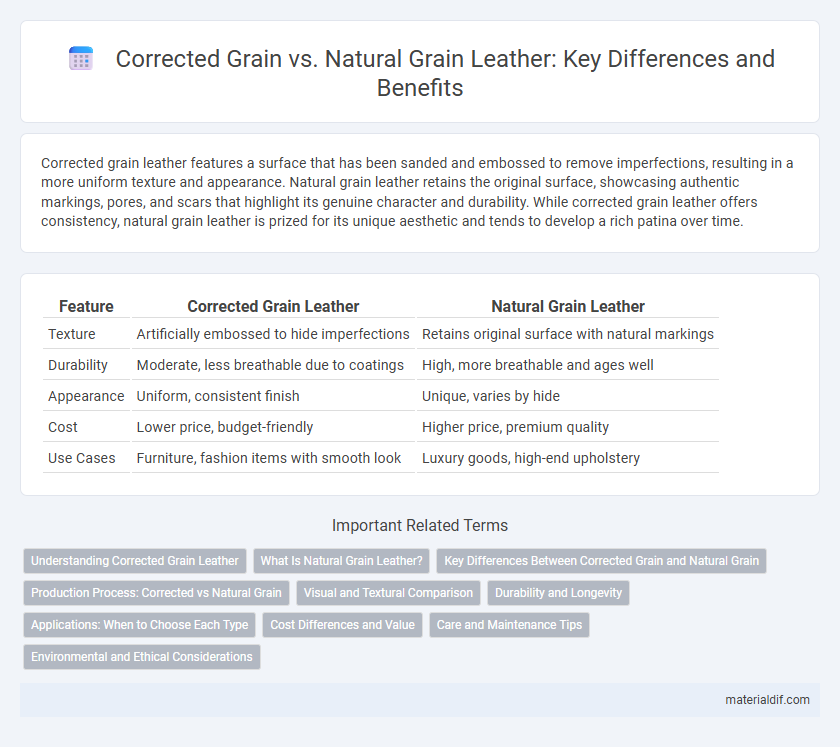Corrected grain leather features a surface that has been sanded and embossed to remove imperfections, resulting in a more uniform texture and appearance. Natural grain leather retains the original surface, showcasing authentic markings, pores, and scars that highlight its genuine character and durability. While corrected grain leather offers consistency, natural grain leather is prized for its unique aesthetic and tends to develop a rich patina over time.
Table of Comparison
| Feature | Corrected Grain Leather | Natural Grain Leather |
|---|---|---|
| Texture | Artificially embossed to hide imperfections | Retains original surface with natural markings |
| Durability | Moderate, less breathable due to coatings | High, more breathable and ages well |
| Appearance | Uniform, consistent finish | Unique, varies by hide |
| Cost | Lower price, budget-friendly | Higher price, premium quality |
| Use Cases | Furniture, fashion items with smooth look | Luxury goods, high-end upholstery |
Understanding Corrected Grain Leather
Corrected grain leather undergoes a surface treatment where imperfections are sanded off and a pigment coating is applied, resulting in a uniform appearance and enhanced durability. Unlike natural grain leather, which retains its original texture and markings, corrected grain leather is ideal for products requiring consistent color and smooth finish. This type of leather offers increased resistance to stains and scratches, making it a practical choice for furniture and automotive upholstery.
What Is Natural Grain Leather?
Natural grain leather is derived from the top layer of the animal hide, retaining its original texture and pores, which contribute to its durability and breathability. Unlike corrected grain leather, it is not sanded or buffed to remove imperfections, preserving the natural markings and unique characteristics of each hide. This type of leather is prized for its authenticity, patina development, and superior strength over processed leather varieties.
Key Differences Between Corrected Grain and Natural Grain
Corrected grain leather undergoes surface sanding and buffing to remove imperfections, then receives an artificial grain coating for uniform appearance and enhanced durability. Natural grain leather retains the original hide's texture and markings, offering a more breathable and supple material with a unique character reflecting natural flaws. While corrected grain is more resistant to stains and scratches, natural grain provides superior aging and develops a rich patina over time.
Production Process: Corrected vs Natural Grain
Corrected grain leather undergoes a surface sanding or buffing process to remove imperfections, followed by an artificial grain application and coating for uniform texture and enhanced durability. In contrast, natural grain leather preserves the original animal hide surface with minimal alteration, retaining natural markings and breathability. Production of corrected grain prioritizes aesthetics and consistency, while natural grain emphasizes authenticity and natural feel.
Visual and Textural Comparison
Corrected grain leather undergoes surface sanding and embossing to create a uniform texture, resulting in a smoother and more consistent appearance, while natural grain leather retains its original surface markings such as pores and scars, offering a more authentic and varied look. Texturally, corrected grain feels more even and polished due to the coating and embossing process, whereas natural grain leather provides a richer tactile experience with its natural imperfections and softer, breathable feel. This visual and textural distinction makes natural grain leather highly prized for its originality, while corrected grain is favored for its durability and standardized aesthetics.
Durability and Longevity
Corrected grain leather undergoes surface sanding and artificial embossing to remove imperfections, resulting in a uniform appearance but slightly reduced breathability and durability compared to natural grain leather. Natural grain leather retains the hide's original texture and pores, enhancing its strength and ability to develop a unique patina that improves with age. The inherent toughness of natural grain leather generally ensures greater longevity and resistance to wear, making it preferable for high-use applications.
Applications: When to Choose Each Type
Corrected grain leather is ideal for heavy-use applications such as furniture upholstery, automotive interiors, and work gloves, where durability and uniform appearance are essential. Natural grain leather suits luxury products like high-end handbags, shoes, and jackets, offering breathability, natural texture, and premium aesthetics. Choosing corrected grain leather ensures resistance to wear and easy maintenance, while natural grain leather provides unique character and superior comfort over time.
Cost Differences and Value
Corrected grain leather undergoes sanding and coating to mask imperfections, resulting in a lower production cost compared to natural grain leather, which retains its original surface with visible unique markings. Natural grain leather commands a higher price due to its durability, breathability, and aesthetic authenticity that increase product value and longevity. Choosing corrected grain offers affordability but compromises on natural texture and long-term resilience, while natural grain leather provides premium quality and investment value.
Care and Maintenance Tips
Corrected grain leather requires regular cleaning and conditioning to maintain its smooth finish and prevent cracking, as its surface has been sanded and treated to conceal imperfections. Natural grain leather benefits from gentle cleaning with a damp cloth and periodic application of natural oils or conditioners to preserve its breathable, durable surface and enhance its unique patina. Avoid harsh chemicals and excessive moisture for both types to extend their lifespan and keep the leather supple and attractive.
Environmental and Ethical Considerations
Corrected grain leather undergoes extensive sanding and chemical treatments to remove surface imperfections, which can increase environmental impact due to the use of harsh chemicals and energy in processing. Natural grain leather maintains the hide's original texture and breathability, reducing the need for chemical treatments and supporting more sustainable practices. Ethically, natural grain leather aligns better with eco-conscious consumers seeking durable, less processed materials that have a lower environmental footprint.
Corrected Grain vs Natural Grain Infographic

 materialdif.com
materialdif.com